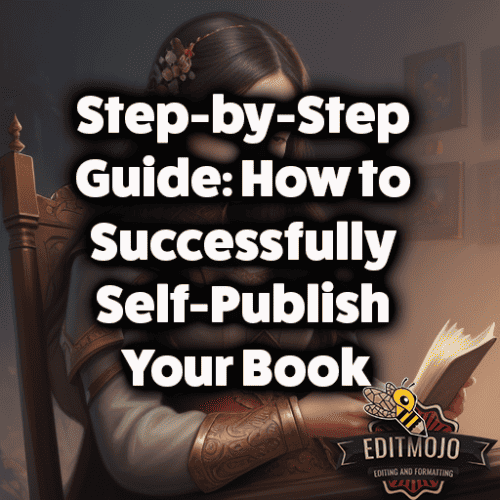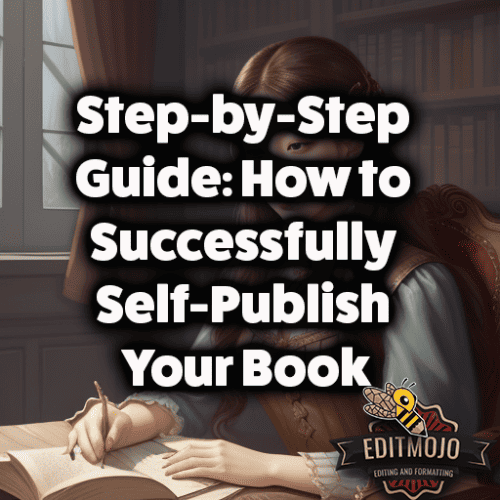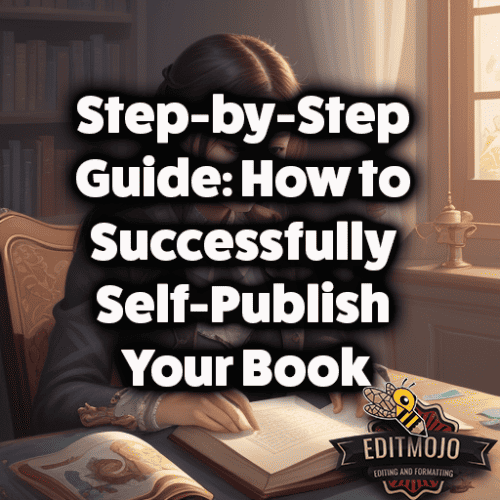Step-by-Step Guide: How to Successfully Self-Publish Your Book
Step-by-Step Guide: How to Successfully Self-Publish Your Book. The publishing landscape has significantly evolved, with self-publishing emerging as a popular choice for authors who desire more control and potentially higher profits. This comprehensive guide will lead you step by step through the entire process of self-publishing a book, from drafting your manuscript to launching your book on the market.
Key Takeaways Table
| Stage | Key Takeaway |
|---|---|
| Deciding to Self-Publish | Self-publishing gives you control but requires you to handle every aspect of the publishing process. |
| Preparing Your Manuscript | A high-quality manuscript is essential. Consider professional editing and beta readers. |
| The Art of Book Design | A compelling cover and professional formatting are crucial to attract readers. |
| Creating a Brand for Yourself as an Author | Establish your author brand through a website, social media, and a compelling bio. |
| Navigating the ISBN and Copyright Process | An ISBN is necessary for distribution, and copyright protects your work. |
| Deciding on the Right Self-Publishing Platform | Research each platform’s distribution channels, royalties, and formatting requirements. |
| Pricing Your Book | The price can impact your sales. Research similar books and price competitively. |
| Marketing and Promoting Your Book | Start promoting before launch. Utilize social media, encourage reviews, and engage with your email list. |
| Post-Publication Tasks | Track your sales and feedback. Start planning your next book. |
Deciding to Self-Publish
Before embarking on the journey of self-publishing, it’s essential to understand the distinct paths in the world of publishing. Traditionally, publishers control the editing, marketing, and distribution of your book, but they also take a significant portion of the profits. On the other hand, self-publishing allows you to retain full control (and profits), but it also requires you to handle every step of the process.
If you’re comfortable with wearing multiple hats and motivated to learn the ropes of the publishing industry, self-publishing may be an ideal path for you.

Preparing Your Manuscript
The key to successful self-publishing lies in the quality of your manuscript. A captivating, well-edited story is more likely to attract readers and garner positive reviews. Before hiring a professional editor, self-edit your manuscript for plot inconsistencies, character development, and language use.
Once you’ve done all you can, invest in professional editing services. Editing comes in various forms, such as developmental, line editing, and proofreading, each essential in its way. For instance, developmental editing focuses on the overall structure of your book, while proofreading targets grammatical errors. Services like Reedsy can connect you with experienced editors in your genre.
Another vital aspect of preparing your manuscript is obtaining feedback from beta readers—volunteers who read your manuscript before it’s published. Their fresh perspectives can help highlight areas of improvement that you might have missed.
The Art of Book Design
People do judge a book by its cover! A compelling, professionally designed cover can draw potential readers to your book. Remember, your book will be displayed alongside countless others in online platforms; hence, your cover design must stand out.
The interior layout is just as crucial. A well-formatted book enhances the reading experience and demonstrates your professionalism as an author. Consider hiring a professional for this step, as formatting requires knowledge of specific software and design principles.
Each platform (print, e-book, audiobook) has unique formatting requirements. For example, an e-book has a reflowable text, while a printed book does not. Understanding these differences and formatting your book accordingly is crucial. Companies like BookBaby offer professional formatting services tailored to each platform.

Creating a Brand for Yourself as an Author
Author branding is the process of creating a unique identity that differentiates you from other authors. It goes beyond your book; it’s about marketing yourself. Your brand should reflect who you are as an author and what readers can expect from your work.
One way to establish your brand is through an author website. A professional-looking website can serve as a hub for your author activities, where readers can learn more about you, your books, and any upcoming events or releases.
In addition, an active social media presence helps you engage with your readers, promote your work, and gain new followers. Tailor your content to each platform. For instance, Instagram is great for sharing visuals, like your book cover or a sneak peek into your writing process, while Twitter is excellent for joining writing communities and participating in trending discussions.
Your author bio is another branding tool. A well-written bio can help form a connection with your readers.
Include relevant credentials, interesting personal tidbits, and don’t forget to mention your published work.
Navigating the ISBN and Copyright Process
An ISBN (International Standard Book Number) is a unique identifier for your book, necessary for distribution and sale. The process for obtaining an ISBN varies by country. In the US, you can purchase an ISBN from Bowker.
Copyrighting your work is crucial to protect against infringement. While your work is technically copyrighted the moment it’s created, formally registering your copyright provides stronger legal protection. The U.S. Copyright Office’s website provides detailed instructions on registering your work.

Deciding on the Right Self-Publishing Platform
There are numerous self-publishing platforms available, each with its benefits and limitations. Amazon’s Kindle Direct Publishing (KDP) is one of the most popular platforms due to its vast audience. Other options include Smashwords, which distributes to multiple retailers, and Lulu, which offers a variety of print options.
Take the time to research each platform, paying attention to their royalty structures, distribution channels, and formatting requirements.
Pricing Your Book
The price of your book can significantly impact your sales. Pricing too high might deter potential buyers, while pricing too low might undervalue your work. A good strategy is to research books similar to yours and price competitively.
Remember, different platforms offer different royalties, which might affect your pricing. For instance, Amazon offers higher royalties for books priced between $2.99 and $9.99.
Marketing and Promoting Your Book
A strong marketing strategy is crucial for the success of your book. Start by building hype before the book launch. You can share sneak peeks, create engaging content related to your book’s theme, or host giveaways to create buzz.
Use your social media channels to promote your book. Engage with your audience, join relevant communities, and consider paid ads to reach a broader audience.
Book reviews can significantly influence a reader’s decision to purchase your book. Encourage readers to leave reviews, and consider sending advance reader copies (ARCs) to reviewers.
Amazon offers promotional tools like Kindle Countdown Deals or Free Book Promotion that can help boost visibility. An engaged email list can also be a powerful tool for promotion.
Post-Publication Tasks
Once your book is published, your work is far from over. Keep track of your sales and royalties, and respond to reader feedback. Negative reviews can provide valuable insight into areas for improvement in your next book.
And speaking of your next book, start planning it! Maintaining a consistent publishing schedule can help retain readers and build your author brand.
Conclusion (Step-by-Step Guide: How to Successfully Self-Publish Your Book)
Self-publishing is a rewarding yet challenging journey that demands time, effort, and strategic planning. But seeing your book out in the world, enjoyed and appreciated by readers, makes it all worth it. Remember, every successful author started somewhere, so take that first step, and who knows where your self-publishing journey might lead?
Happy writing!
Resources for Self-Publishing (Step-by-Step Guide: How to Successfully Self-Publish Your Book)
Here are some helpful resources to guide you on your self-publishing journey:
- The Creative Penn: A blog full of resources on writing, self-publishing, book marketing, and creativity.
- Writer’s Digest: Offers a variety of resources, including writing tips, industry updates, competitions, and webinars.
- KDP University: Offers resources for using Amazon’s KDP, including how-to guides and webinars.
- Self-Publishing Formula: Provides courses, podcasts, and resources for self-publishing.
- Alliance of Independent Authors: A professional association for self-publishing authors. Offers advice, support, and industry news.
Remember, self-publishing is a marathon, not a sprint. Enjoy the journey and best of luck with your publishing adventure!
Top Five Questions and Answers Table
| Questions | Answers |
|---|---|
| Q1: What’s the first step in self-publishing a book? | A1: The first step is deciding if self-publishing is the right choice for you, considering the effort, time, and monetary investment involved. |
| Q2: How important is professional editing and design in self-publishing? | A2: Extremely important. Professional editing ensures your book is of high quality, and professional design (both cover and interior) greatly impacts your book’s marketability. |
| Q3: How do I choose the right self-publishing platform? | A3: Research the royalty structures, distribution channels, and formatting requirements of various platforms like Amazon KDP, Smashwords, and Lulu, and choose the one that best fits your needs. |
| Q4: How do I price my self-published book? | A4: Research the price range of books similar to yours and price your book competitively. Remember, the pricing may affect your royalties on different platforms. |
| Q5: How can I effectively market my self-published book? | A5: Start marketing before your book’s launch. Use social media, encourage reviews, offer giveaways, and utilize your email list. Consider using Amazon’s promotional tools if you’re using their platform. |
